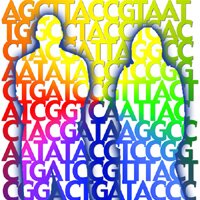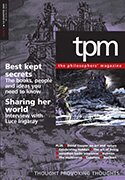Steve Sturdy on how genomics is changing the way we conceive of who we are

(Jane Ades/ NHGRI)
But personal identity involves more than just a sense of individual uniqueness. It is also heavily bound up with our shared membership of different social groups: nationality, ethnicity, kinship, class, occupation, political affiliation, star sign and many other social categories may all loom large in the ways we think about identity. Such collective identities are as much a part of social life as individuality. They constitute the warp and weft of the variegated social tapestries through which we thread our individual lives, and from which we construct our individual biographies. They serve both to bind and to divide society. And if we look at how new genomic technologies are being employed to define who we are, their impact has overwhelmingly been on how we identify ourselves as members of particular social groups.
Race and ethnicity is an obvious example. Study of the genetics of human populations makes clear that the subdivision of the human species into distinct races on grounds of skin colour and other conventional markers of race is unsupported by any underlying genetic or evolutionary basis; there is simply too little genetic difference between these supposedly different racial populations, and too much genetic traffic between them, for them to be considered distinct in any biologically meaningful sense. Racial distinctions may be a social reality, but they are not rooted in biological reality. Nonetheless, genomic technologies are widely employed in ways that tend to reify racial and ethnic divisions.
The International HapMap Project, for instance, is a multi-country scientific collaboration that ostensibly sets out to catalogue the global diversity of human genetics. But the project has chosen to concentrate on characterising four relatively discrete population groups – Han Chinese from Beijing; Tokyo Japanese; Yoruba people from Ibadan, Nigeria; and Utah-resident Americans with northern and western European ancestry – that effectively reproduce conventional racial categories. Findings from this and other work on global genetic variation in turn feed back into how race and ethnicity are perceived as social categories. Bundles of genes identified with particular geographical localities are commonly re-described in racial terms, for instance when used to identify populations at risk of certain diseases or to generate suspect profiles from forensic DNA evidence.
This tendency to essentialise racial and ethnic categories in genetic terms is not confined to scientific and other official agencies. Some ethnic groups actively collude in such processes, particularly where confirmation of ethnic identity may confer certain social or other advantages. Sections of the Jewish diaspora, for instance, have embraced evidence of a shared genomic inheritance as a means of consolidating their collective identity and reinforcing their claims to have historic roots in present-day Israel.
But such evidence has also created opportunities for other groups to claim Jewish identity. The Lemba, a dark-skinned Southern African people, have long professed to be descended from a common Jewish ancestor. Genomic investigations have recently shown that a significant number among the Lemba’s hereditary male priesthood possess a peculiar Y chromosome haplotype that is also prevalent among Jewish Cohens – a finding that lends considerable credence to what was previously regarded as a mere oral tradition of dubious provenance. Such findings potentially extend Jewish identity to ethnic groups well beyond those that have historically been regarded as genuine Jews, with possible political consequences should such groups go on to claim Israeli residency or citizenship.
These kinds of examples can be multiplied. In the United States, genomic evidence of Native American descent is increasingly being used to adjudicate claims to be interred in ancient burial grounds, to open casinos, or to practise as “native” artists. Meanwhile, private companies are cashing in on the boom in “recreational genealogy” by offering DNA tests that purport to yield evidence of geographical and ethnic origins. Claims about ethnic identity are thus coming increasingly to rest, not solely on social criteria, but on evidence produced by new genomic technologies.
Questions of descent and relatedness embrace not only issues of ethnicity, but also of family and kinship. Here too, genomic technologies and genetic perspectives are subtly influencing how we define identity. As anthropologists have long appreciated, kinship is one of the fundamental frameworks around which human societies are organised. The ways in which kinship and relatedness are assigned vary enormously across different societies, and only rarely map in any simple way onto patterns of genetic relatedness. But the rapid growth and implementation of genomic technologies is doing much to consolidate the idea that genetic relatedness represents a particularly “true” form of kinship.
For instance, genomic techniques have been recruited to reinforce long-standing conventions of patrilineal inheritance, both through the widespread adoption of paternity tests to determine who should bear financial responsibility for children, and through high-profile cases such as the demonstration that some male descendants of Thomas Jefferson’s slave Sally Hemings carried a Y chromosome inherited from the Jefferson line, and most likely from Jefferson himself.
The use of mitochondrial DNA to demonstrate descent through the female line is notably less common, though both Y chromosome and mitochondrial DNA haplotyping – the identification of particular patterns of mutations shared between relatively large populations of individuals who are not directly related to one another – are commonly used to identify the likely geographical or ethnic origins of distant ancestors.
But privileging such practices to determine parentage and descent also tends to devalue other forms of kinship, including non-biological relationships such as adoption. This is apparent in the language surrounding recent moves to give adopted children, and those born as a result of donor-assisted conception, the right to know the identity of their genetic parents. Talk of genetic parentage routinely slips into talk about “true”, “real” or “natural” parents, while pro-life campaigner David Alton goes so far as to equate genetic inheritance with “identity” pure and simple. By such language, the social aspects of parenting are sidelined or even written out altogether. Yet this is to exclude what many would consider a vitally important dimension of kinship.
This is particularly apparent in the way that different populations have responded to the introduction of DNA tests as a means of proving kinship for immigration purposes. The adoption of such tests by the British immigration services has been largely uncontroversial. The majority of British immigrants come from the Indian subcontinent, where kinship patterns tend to follow lines of biological relatedness; consequently, for Indian and Pakistani immigrants wishing to bring their families into Britain, DNA testing actually provides a welcome opportunity to demonstrate biological relatedness in the face of official suspicion.
The situation in France is very different. Many of those seeking entry into France come from African countries where ideas of parentage do not necessarily imply strict biological progeniture. Moreover, many come from countries disrupted by war or famine. Under such circumstances, orphaned children are commonly adopted by relatives or friends – though the disruption of civil bureaucracies often means that such adoptions are not officially documented. Such families routinely fail the test of biological relatedness imposed by the French immigration authorities, and many are broken up or refused admission. Opposition to the use of DNA tests and the privileging of biological over social parentage has accordingly been bitter and sustained among French immigrant communities.
As well as race and family, genomics also helps to underwrite the establishment of other, newer kinds of group identity. In recent decades, novel identities have been created through the formation of social movements to further the interests of sufferers from certain diseases. Where those diseases can be shown to be strongly linked to the inheritance of particular genes, as in Huntingdon’s chorea, this has served to extend the disease identity beyond those with symptomatic disease, to include relatives and other carriers of the relevant genes. Moreover, the identification of groups at risk from genetic disease is expanding rapidly, as medical and pharmaceutical agencies commit massive resources to identifying genes that predispose to an increasingly wide range of conditions. More and more people are being identified as belonging to one or more genetic risk categories, with potentially profound impacts on everyday life in terms of lifestyle advice, medical intervention or inflated insurance premiums.
Such genetic disease identities can in turn interact in unpredictable ways with other kinds of group identity. The high incidence of Tay-Sachs disease among Ashkenazi Jews, for instance, has if anything reinforced the sense that Jewishness is a genetic as much as an ethnic identity. Conversely, ethnic identity can inform perceptions of genetic risk: for instance, medical evidence that genes predisposing to cystic fibrosis are less common among African-Americans than in the population as a whole has actually tended to exacerbate under-diagnosis of the disease in African-American children, as doctors tend to assume that these children’s symptoms must be due to other causes.
Again, these kinds of interactions between disease identity and ethnic identity are likely to proliferate as pharmaceutical companies and other medical agencies seek new ways of tailoring prophylactic and therapeutic interventions ever more precisely to specific markets. Already, a pharmaceutical preparation called BiDil, used for treating congestive heart failure, has been licensed in the USA for use exclusively among African-Americans. In this instance, genomic evidence was not employed to define the particular population among whom the drug was found to be most effective, which consisted of self-identified African-Americans. But the manufacturer’s success in gaining approval for a racially-targeted medication will almost certainly pave the way for further drug approval applications in which genomic criteria of both ethnicity and disease susceptibility will be deployed. In so doing, the likelihood is that pharmaceutical companies and licensing agencies will further entrench the supposition that racial identities are primarily genetic in character, characterised not least by the diseases to which they are congenitally susceptible and the medications to which they are constitutionally best suited.
Insofar as genomics is having an impact on our sense of identity, then, it would appear that it is being used far more for the purpose of assigning us to particular social categories – be they familial, racial or pathological – than for bolstering our sense that we are unique individuals. Such processes are often unpredictable and even contradictory; genomic redefinitions of ethnic identity, for instance, may problematise as well as reinforce existing categories, as we have seen in the case of Jewishness. Equally, genomic measures of similarity and difference may serve to transcend as well as to inscribe the boundaries between social categories and even between species; the observation that we share 98% of our genes with chimpanzees is often invoked to emphasise our behavioural and physiological similarity to other primates (though less is made of the fact that we also share 35% of our genes with daffodils). But on the whole, the tendency is towards finding new ways of categorising humanity into distinct genomic sub-groups.
We should probably not be surprised by this. At least since Darwin, ideas about biological inheritance and descent have been used as a means of drawing lines of similarity and difference between sections of the human species, as well as between humanity and the rest of the natural world. Genomics is simply the latest scientific tool to be pressed into such service.
But the advent of genomics does raise some novel issues. New genomic technologies provide more robust, discriminating and reproducible methods of assigning biological identity than anything that has previously been available; while the adoption of such technologies by a growing variety of social agencies – including government and industry, social movements and private individuals – is already proceeding on a massive scale. Given the extent to which these technologies are becoming embedded in everyday life, it seems inevitable that they will come to play an increasingly important role in the way we construct our individual and collective identities.
The eventual outcome of this process of genomicisation remains difficult to predict; as we have seen, the dynamics of genomic identification are complex and often contradictory. At present, however, it seems that the overwhelming tendency is towards ever more fine-grained definitions of kinship, ethnicity and health status. Perhaps most importantly, the material character of these new technologies of genomic identification, and the fact that they are so robust and reproducible, makes them much harder to challenge than earlier forms of biological categorisation. Where such technologies are involved, group membership becomes less a matter of individual or collective judgement, and more a matter of technological determination. Increasingly, it seems, the power to determine identity – both individual and collective – is becoming invested in new genomic technologies, and in those sections of society who have access or control over those technologies.
Steve Sturdy is deputy director of the ESRC Genomics Policy and Research Forum at The University of Edinburgh
 Email This Post
Email This Post 



Well written. Nice to see that Nature VS Nurture is still wide open!
Merry Christmas,
ET
[...] Magazine | The biology of identity January 6, 2010 — translatorpower via philosophypress.co.uk Posted in Uncategorized. Leave a Comment [...]
[...] The biology of identity 2010 February 1 by psgsousf Steve Sturdy in The Philosopher’s Magazine: [...]